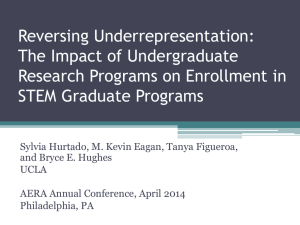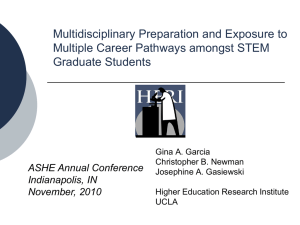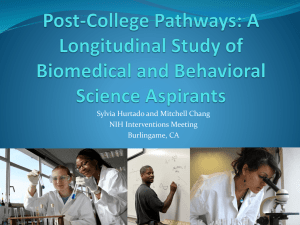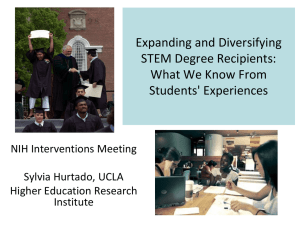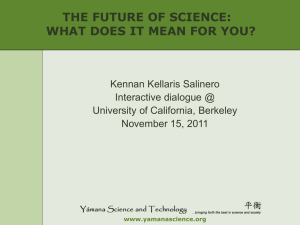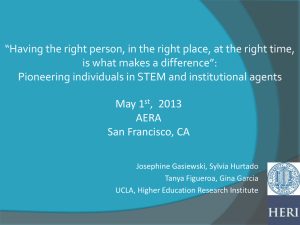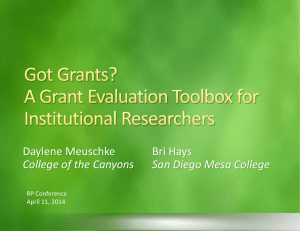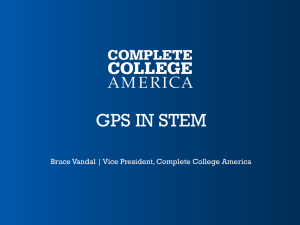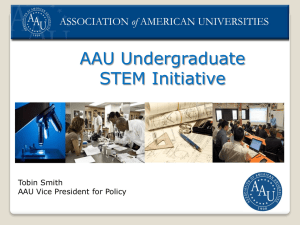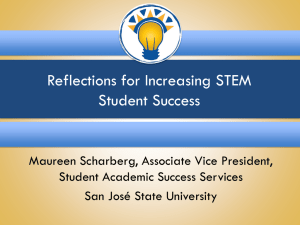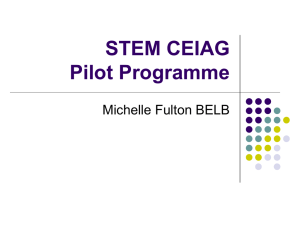National STEM Data -SACNAS - Higher Education Research Institute
advertisement
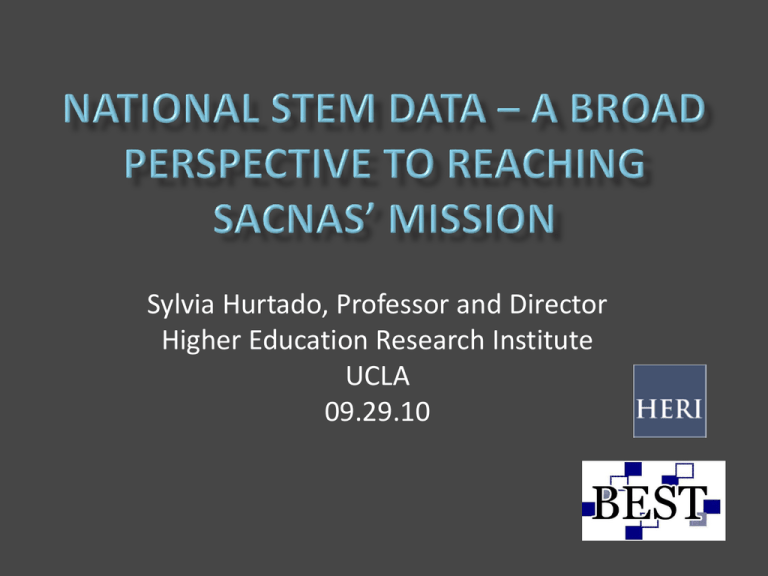
Sylvia Hurtado, Professor and Director Higher Education Research Institute UCLA 09.29.10 Original NIH (2004): Promoting Diversity, Access, and Engagement NSF (2008): Becoming Scientists: Practices in Undergraduate Education that Contribute to Degree Completion and Advanced Study in STEM Disciplines Current NIH (2008): Post College Pathways: A Longitudinal Study of Biomedical and Behavioral Science Aspirations ARRA (2009): Introductory STEM Courses: Sorting, Harvesting, or Nurturing Student Talent • STEM fields experience high attrition rates at various points in the educational pipeline • • • Particularly URM students Affects expansion and diversity of STEM fields United States maintaining competitive standing as other countries gain in scientific innovation Lack of exposure to multiple career pathways at the graduate level Intersection of multiple identities while navigating degree completion (SACNAS helps with the intersection of identities) Integration of social science theories and conceptual models into practice Percentage of 2004 STEM Aspirants Who Completed STEM Degrees in Four and Five Years, by Race/Ethnicity 45 40 35 30 25 20 15 10 5 0 4-Year Completion White Asian American 5-Year Completion Latino Black Native American • Role of introductory courses • Efficacy of undergraduate research programs • Best practices in STEM • Institutional and academic major context • Pathways to and through graduate school Planned to work in science/tech job in 2008 Planned to enroll in graduate school in 2008 Planned a STEM-related career in 2008 Chicano Native American Participated in undergraduate research program Freshman plans for a STEM Career 0 20 40 60 80 100 Planned to work in a science/tech job in 2008 Chicano Native American Plan to enroll in graduate school in 2008 0 10 20 30 40 “When it comes to grad studies, I think, one question that needs to be asked is, do students feel like they're offered a variety of opportunities …how flexible is your program towards allowing you to choose other career paths? Is your program flexible in the light of today's realities for scientists?” “I made the howling mistake a couple of years ago of mentioning that once I finished my PhD I was interested in teaching high school level biology at which point everyone decided, ‘Well, you don’t need a PhD so why are you still here?’” Source: Carlone & Johnson (2007).Journal of Research in Science Teaching, 44 (8). Competence Students talk about science differently in the classroom, in a professor’s project, or in a structured research program (peers, dedicated faculty) Recognition Institutional ethos – “We do science here” Peer culture Proximal contexts, faculty belief in students’ potential and determination to succeed Emergent Results Knowledge/content is to be mastered (memorized) versus knowledge can be discovered and “owned” Science is competitive, getting right answers vs. collaborative using both challenge and support More ways of demonstrating competence Failure in scientific work is OK Rethink and try again until one succeeds Validation from faculty and peers Students’ ability to cram for exams, previous preparation in high school, time spent working in small groups, and time spent tutoring another student positively predicted GPA GPA was not significantly related to changes in thinking and acting like a scientist in courses Students who were overwhelmed with course expectations not only had lower GPAs but were also less likely to think and act like a scientist Implications: Are we assessing and recognizing the broader skills necessary for scientific work? Connection to BBS discipline positively predicts BBS retention Becoming more domain identified and having a frequency of negative racial experiences exacts a higher toll on URM students’ chances of persisting Joining pre-professional/departmental club increases odds of BBS retention Receiving advice from faculty about academic program increases chances of BBS persistence Selective institutions negatively affect persistence URM students and women of color had higher odds of STEM persistence STEM if they: joined student organizations related to their major discussed course content outside of class participated in undergraduate research programs Entered college with higher SAT scores Attended an institution with a higher concentration of STEM students URM students and women of color had lower odds of STEM persistence STEM if they: Worked full-time while in college Initially aspired to earn a medical degree Attended a more selective institution Only a quarter of URMs were going directly into graduate school in the fall of 2008, compared to a third of White/Asian students One in five were applying to graduate school in the fall of 2008 Half were looking for a job or found a job One in five were working in a job related to science, but only about 8% wanted scientific research as a long-term career URM STEM majors had higher odds of enrolling in graduate school if they: Came from more affluent backgrounds Earned higher cumulative GPAs in college Worked on a faculty member’s research project Had a stronger connection to STEM in their senior year Majored in the physical sciences (compared to engineering/computer science) Attended a private institution Attended an HBCU URM STEM majors had lower odds of enrolling in graduate school if they: Relied on personal funds to finance their senior year of college Completed college with higher amounts of student loan debt Indicated that they had come to college to be able to make more money RACE: “I’m super visible and then at the same time I wanna be myself. …there’s not very many people of color in my department and so you’re always trying to figure out , ‘Okay, am I under a special kind of magnifying glass?’” RELIGION: “…I feel like religion’s a very important thing to me. And there’s a huge tension there between like being someone who’s religious and being a scientist. Like a lot of people think those things are totally incompatible. And I couldn’t disagree more.” FAMILY BACKGROUND: “So, I find myself often downplaying it with even extended family or when I go to my hometown hair salon. And they're like, wow, you're going to be a doctor, right? And I'm like, oh, it's no big deal. It's just a Ph.D. and it's just another degree. I find myself saying those types of things a lot, because I don't want other people who haven't had that opportunity in my family to feel that I feel that I'm better than them or anything like that.” GENDER: “And I think you wear different hats depending on who you’re talking to. I think something I’ve been feeling recently is my female identity and my science identity. I was involved with a grant writing process and I’m 24 years old and female. And everyone else around the table were over 50 and white males. And I really, for the first time in my life I felt very different. And I think it’s interesting that I’m starting to feel the presence of a glass ceiling based on gender. And I’ve never felt that before. Which is ironic cause of our generation there are more women in science than men.” “I came in with a real focus on teaching, and then our program in fact discourages you from doing any teaching. We have to get permission if we want to even TA or assist in the lab. We have to get permission from our mentor and from the head of the graduate group. Most of the time, somebody says ‘no’ along the way.” “I’d give it [the teaching] an ‘F’. I think it’s really, really bad. Very poor quality. I didn’t learn anything. It’s pretty obvious that most of our professors don’t really want to teach and that they don’t put in the time to even organize the class. “ Papers and reports are available for download from project website Project email: herinih@ucla.edu • Project website: www.heri.ucla.edu/nih RESEARCH STAFF Sylvia Hurtado, Co-PI Mitch Chang, Co-PI Postdoctoral Scholars Kevin Eagan Josephine Gasiewski Graduate Assistants Gina Garcia Juan Garibay Felisha Herrera Monica Lin Cynthia Mosqueda Christopher Newman Jessica Sharkness Minh Tran
